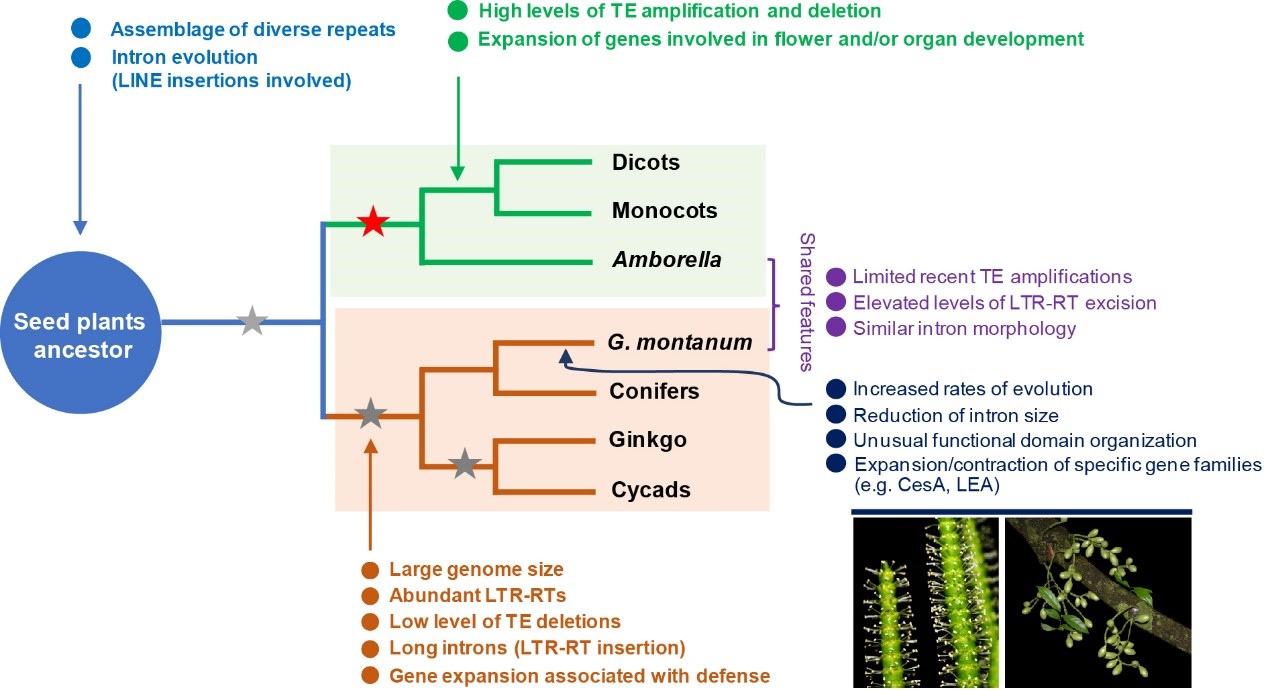| 设为首页 | 加入收藏 |
|
English |

仙湖植物园、中-非中心等单位在早期种子植物演化问题研究中取得重要进展
近日,由深圳中科院仙湖植物园、中科院中-非联合研究中心、深圳兰科植物保护研究中心、诺禾致源(Novogene)、英国皇家植物园邱园(Kew)、中科院植物所、中科院武汉植物园、武汉大学等10余家国内外知名院所联合开展的“裸子植物——买麻藤全基因组计划”取得重要进展。相关研究成果于2018年1月29日在国际学术权威刊物《自然》出版集团旗下子刊《Nature Plants》杂志上以封面长文形式在线发表。题目为“A genome for gnetophytes and early evolution of seed plants”。中-非中心植物多样性保护首席研究员、深圳中科院仙湖植物园副研究员万涛为文章第一作者,中-非中心主任王青锋研究员为共同通讯作者。来自亚利桑那大学的知名基因组进化研究专家Michael S. Barker 专门撰文评述了该项研究工作的重要意义。
裸子植物和被子植物的起源、分歧及演化,是现代植物学科的基础热点领域。现存35万余种种子植物被分成苏铁类、松柏类、银杏、买麻藤类(裸子植物)和有花植物(被子植物)五大类。其中,买麻藤类植物因其独有的形态特征以及历史研究背景,一直受到世界植物学家的广泛关注。据目前认识,现代买麻藤类植物的出现至少始于早白垩纪,伴随着冈瓦纳古陆的分离,以现今非洲(主要在西非)为起源中心,逐步形成了洲际间断分布的物种多样性格局。一个多世纪来,科学界对买麻藤类植物的系统分类地位持续争论,不同假说层出不穷,迄今仍未有定论,号称“百年之争”。
项目组通过对接近4.5 G的买麻藤(G. montanum)进行了全基因组测序组装,同时结合转录组数据,对现今已发表的17种代表性陆地植物进行了全基因组比较及相关分析。研究发现,买麻藤的基因组特征显著区别于其他已发表的种子植物类群(针叶树、银杏、被子植物),其在某些特定的,如内含子、重复序列进化等特征上,与现存最古老的被子植物无油樟“相似”。此外,买麻藤在种子植物保守功能基因集合(现存种子植物共享)上呈现出非常古老的状态,暗示其并未发生剧烈的家族扩张和收缩。
文章从基因组层面,全面分析并呈现了买麻藤独有的“特质”,帮助我们对种子植物共同祖先的特定基因组特征进行了推演和讨论,同时也对目前作为针叶树(Conifers)姐妹群的假说("Gnepine","Gnecup" or "Gnetifer")提供了新的思考和视角,暗示种子植物早期的演化比我们想象中更为复杂。

图1 基于现有种子植物系统关系的各个代表分支的基因组特征及产生原因

图2 从左到右依次为:买麻藤的雌球花、百岁兰的雄球花和麻黄的雌球花(比例尺:5 cm)
原文链接:http://www.nature.com/articles/s41477-017-0097-2
原文摘要:Gnetophytes are an enigmatic gymnosperm lineage comprising three genera, Gnetum, Welwitschia and Ephedra, which are morphologically distinct from all other seed plants. Their distinctiveness has triggered much debate as to their origin, evolution, and phylogenetic placement amongst seed plants. To increase our understanding of the evolution of gnetophytes, and their relation to other gymnosperms and seed plants, we report here a high-quality draft genome sequence for Gnetum montanum - the first for any gnetophyte. By using a novel genome assembly strategy to deal with high levels of heterozygosity, we assembled > 4 Gb of sequence encoding 27,491 protein-coding genes. Comparative analysis of the G. montanum genome with other gymnosperm genomes unveiled some remarkable and distinctive genomic features, such as a diverse assemblage of retrotransposons with evidence for elevated frequencies of elimination rather than accumulation, considerable differences in intron architecture, including both length distribution and proportions of (retro) transposon elements, and distinctive patterns of proliferation of functional protein domains. Furthermore, a few gene families showed Gnetum-specific copy number expansions (e.g. CesA) or contractions (e.g. LEA), which could be connected with Gnetum’s distinctive morphological innovations associated with their adaptation to warm, mesic environments. Overall, the G. montanum genome enables a better resolution of ancestral genomic features within seed plants, and the identification of genomic characters that distinguish Gnetum from other gymnosperms.
版权所有:中国科学院中非联合研究中心 中国·武汉 邮编:430074
电话:+86-27-87700875 电子邮件:sinafrica@wbgcas.cn
技术支持:中国科学院武汉植物园科技支撑中心 鄂ICP备05004779号-1 ![]()